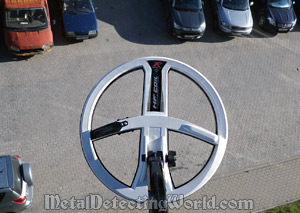The Truth About XP Deus, page 12
12. Field-Testing V4.0 with 9-inch HF Coil
(...CONTINUES from Previous Page)

With the 9" HF coil, operated on 27 kHz, I did not find any coins at the test-site either; thus, proving that not only the HF coil was not an every-day, all-around coil, but also that it did not find anything the legacy 9" LF black coil operating on 18 kHz in the V3.2 could not find!
However, with the HF coil, the Deus V4.0's performance was more stable than with the LF coil. And, at the most challenging, iron-infested spots in my test-area, I managed to find the tiniest non-ferrous targets - the microscopic bits of sheet copper and a few lead birdshots of 3 mm in diameter, on and near the ground surface!
At the spots with scarce iron junk, I also found a few superficial, tiny low-conductors. But I did not hear any whispering audio responses to coins and the non-ferrous junk targets at medium depths obviously because the High-Frequency coil could not reach them. It is a surface coil. I wished there were coins within the HF coil's maximum reach (6"), but they all had already been taken out by the Deus V3.2 and other detectors.
One thing that I did not like about the HF coil's performance at this site was that the Deus V4.0 audio responses to large iron fragments of the exploded grenades would sound like responses to good, high-conductive non-ferrous targets. This was the best exhibition of the Wrap-Around Effect (also called 'Wrap-Over Effect') I had ever seen.
So, I either had to use specific iron-identifying techniques and a "new" mode - the XY Visualization screen, or simply dig the iron. The latter would be beneficial but also would grandly reduce my time efficiency in the field during normal detecting.
Although the XY Visualization screen had been previously available in the so-called "hidden" menu of the V3.2, I had never used it for a few reasons. The main reason was my reluctance to use any visual Target ID feature while having a sufficient, time-saving tonal Target ID function at my disposal.
The XY screen (page 22 of the Manual) was added to V4.0 to help the HF-coil users identify the iron targets in situations like the one described above. But, even with use of the ZOOM XY mode, the XY Visualization becomes unreliable at the iron-laden spots and the sites with dense modern trash. I was surprised that the XP engineers decided to "legalize" this mode instead of a couple of more effective modes residing in the V2.0-V3.2 hidden menus (all details will be given in one of my upcoming articles).
All in all, the 9" HF coil proved to be capable of detecting the tiniest low-conductors among dense iron rubbish. Considering that and how well the HF coil can cope with extreme mineralization, one can be sure that the HF coils meet the requirements for detecting either gold nuggets (or meteorites) - this is what they were designed for, or the tiniest coins like the Roman minims in the highly-mineralized ground of the "searched-out" sites in the UK and other parts of Europe.
But at my test site containing coins that are much larger than 6 mm in diameter, the HF coil turned out to be absolutely unuseful. In other words, my site's metal detecting conditions were not challenging enough or favorable for the HF coil to shine. However, this coil can benefit those searching for superficial, non-ferrous relics of the small-to-medium sizes, such as military marked buttons, shoe buckles, badges and other insignia, thin and wire-framed objects, etc., at the sites located in pastures and laden with old iron junk only and/or having high levels of mineralization.
I thought about testing this coil on 27 kHz at a regular site of the former homestead. But I decided against it as soon as I realized how much time I would have to waste recovering hundreds of the tiniest, worthless pieces of the non-ferrous rubbish, that are 4 mm and smaller in size. I sure knew that trying to locate and/or spot BB's, birdshots, air gun pellets (4.5 mm in diameter), tips of iron sewing needles (yes, they always sound good), minuscule snips of wire, tiny flakes of foil, microscopic bits of tin and copper, and a zillion of other teensy whatchamacallits in the dug-out piles of dirt or in grass would grandly spoil my metal detecting fun.
How do I know about the above-listed targets without detecting them with the HF coil at the hunt site containing such targets? I have a simple answer: at hunt sites with modern trash, the Deus V3.2 operating on 18 kHz can be easily tuned to sound off on them, and vice versa of course! In this case, some 'Expert' settings can be altered on the standard LF coils operating on 18 kHz to give the same results as that of the HF coils operating on 27 kHz. The small difference is that the optimized-for-gold HF coil can find more of the smallest, non-ferrous and low-conductive bits due to its ability to lift them up from the iron range and make them sound more prominent.
I did not test the 9" HF coil on 57 kHz because I obviously did not have a hunt site with metal detecting conditions that would be favorable for that operating frequency. And what targets would I be testing it on? Gold flakes would do, but I guess I am not too excited to fly thousands miles to the nearest gold fields. At my test sites, the "appropriate" targets would undoubtedly be zillions of non-ferrous specks I would have to deal with during the process. And certainly not without my glasses! All that would completely drive me nuts! I did not think it was necessary.
(CONTINUES on Next Page...)
(CONTINUES on Next Page...)